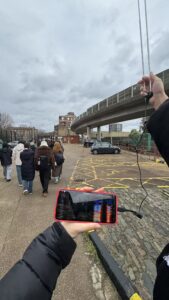
Today in the UK, the weather was cold and grey, but while experiencing this, we were receiving ticking sounds from a satellite and converting them into an image.
Cloudy, windy, a little bit cold.
The resulting image of the sky was striking and different from the one outside, blending technology and nature.
A long cloud through UK.
The climate crisis is evident in my community with more erratic weather patterns, storms, and rising pollution.
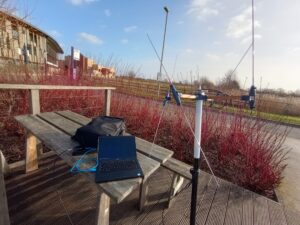
This weather sounding took place during Storm Éowyn.
The contrast between the natural world and the technology used to interpret it highlights both the challenges and potential solutions we face in addressing climate change.
Even when undertaken within the ostensibly sheltered confines of York University campus, the roaring winds were more than sufficient to knock over and scatter the ground station equipment, even as the sounding was taken place!
Having accidentally left out my aerial and SDR for two nights I feared my kit was dead.
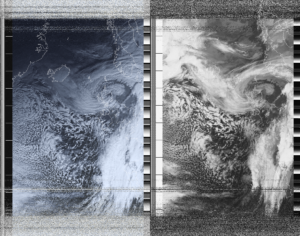
The double cross antenna fell to pieces and had to be repaired and held in position against the wind as NOAA-18 passed overhead - surprisingly, this did not appear to impact the recording.
Having left the kit to dry for a good 24 hours I tried two passes this morning that had such bad interference I felt annoyingly gloomy even with a day of blue skies and sun.
Undoubtedly, the chief source of local concern around the climate crises is in its potential to generate flooding from the nearby rivers Ouse and Fosse.
However after some online forum research and some kind soul giving me some tips for testing it looks like my precious kit is okay.
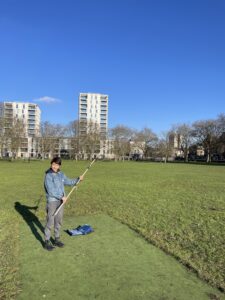
"Has your aerial gotten bigger?" a woman chasing a brown curly haired dog asked me.
The Moon and Venus are neighbours tonight.
"Maybe its just how you're holding it!" she added.
3.7 degrees Celcius
74% humidity
1015 hPa/mb
We laughed as her dog ran away.
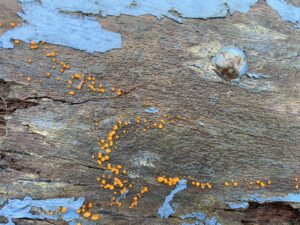
My colleagues joke that January has been a sodden, dark, misty tunnel.
I tried to remember where I had met her before.
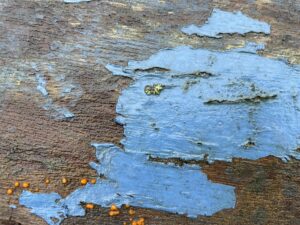
On a decaying picnic table next to the Physics Department, I notice bright orange fungi, like colourful jelly strung across the peeling blue paint.
After a somewhat stormy week, the air is crisp and the sky is a clear blue.
It reminds me of a kind of fungi I once saw in the temperate rainforest at the bank of the Puget Sound, near Seattle.
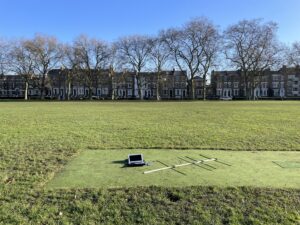
The pressure is around 1023 hPa, suggesting clear weather for the rest of the day.
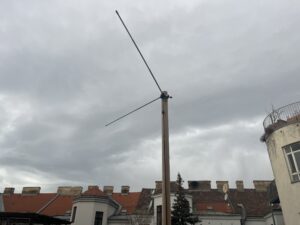
Testing, testing.
I notice that bulbs are already poking up through the grass on the edge of the park.
Same antenna position, same satellite, different dipoles and a lower altitude pass of 54º.
A 2022 study at Cambridge showed that flowers in the UK are blooming an average of one month earlier than they used to, and this is putting them out of sync with the insects that they need to reproduce, and that need them for food.
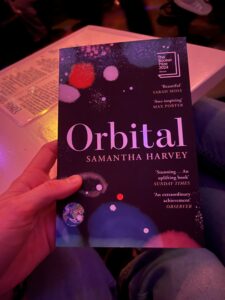
Vienna Inner City weather station at 3pm:
temp.
As of yesterday, the Palisades fire in Los Angeles is 100% contained.
16.8°C
relative humidity 52%
wind South, 29 km/h
precipitation [last hour] 0 mm
Sun [last hour] 19%
air pressure 997.0 hPa
Source: www.zamg.ac.at/cms/de/wetter/wetterwerte-analysen/wien
Checking the Calfire maps every day, often multiple times per day, since Tuesday January 7th was a ritual that I hope I will never have to repeat.
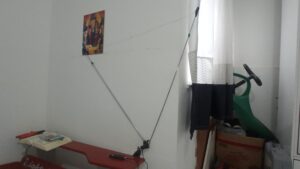
We can see the state of Rio de Janeiro in Brazil completely covered in clouds.
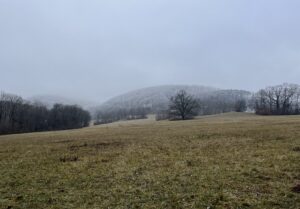
I am experimenting with different DIY antenna set-ups in an effort to reduce the electromagnetic noise that silently engulfs my apartment's balcony.
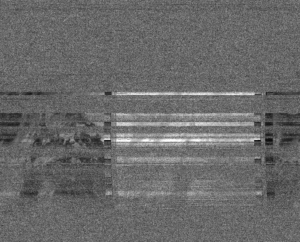
Clear sunny day at Ferrenti Park next to my flat.
Its origin remains a mystery.
I am struggling with getting a clear signal with my di-pole antenna.
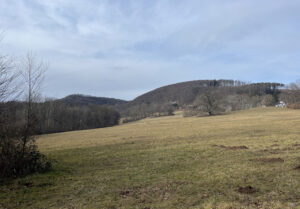
At dusk, as I wedged the wooden pole supporting a new copper v-dipole into an umbrella stand, I could hear a blackbird's distinct evening song.
There is a glimpse of an image between all the noise.
Like me, the bird seemed awakened, and perhaps confused, by the warm weather.
The signal was very sratchy and noisy but clear for a bit when I kept the antenna near my stomach
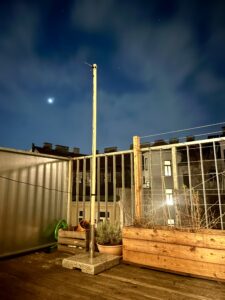
It is spring-like and yet we are January.
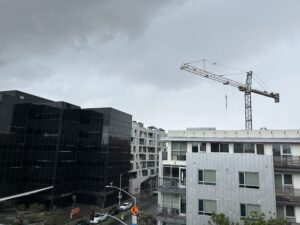
I went to the top of a parking garage in downtown Santa Monica in the hopes of having a clear view of the sky.
Yesterday, the air in the woods smelled moist and leafy as if living things were stirring, breathing.
I didn't get as clear of an image as I hoped for.
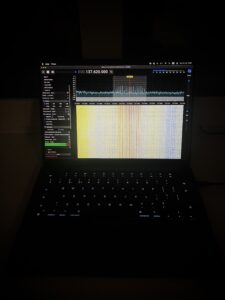
The days have been mostly dry, with broken sunshine.
Perhaps some interference from the surrounding buildings, etc.
Tomorrow afternoon, the temperature is forecast to reach 15 Celsius.
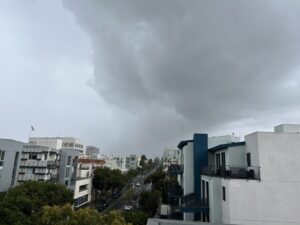
Today was the first meaningful rain event for almost 9 months.
If true, that will be a whopping 20 degree increase on last week.
This has been the driest start of the rain season since records began in 1877.
The photograph on the left was taken on 18 January, the photograph on the right was taken on 26 January.
Not a surprise when 3 weeks ago dry winds conspired in the development of six fires burning simultaneously around Los Angeles.
There appear to be lots of fresh moles hills in the photograph on the right, although it is impossible to say as the framing is different.
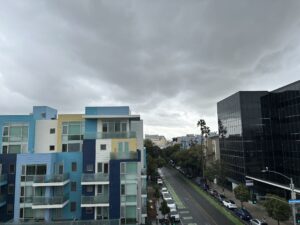
28 lives were lost and over 16 thousand homes destroyed.
After Storm Éowyn.
The human fingerprint is all over this event from the initial ignition, the preparation and response from the fire department, housing development within a flammable ecosystem, and ultimately, the climate crisis.
More wind is on it's way and the sky tonight has layers of higher denser cloud with lower and thinner fast moving cloud that race by across the faces of Jupiter and Venus.
A lot of finger pointing from the new president to the individual.
The breeze is getting stronger and by the time the pass has finished the clouds part like theatre curtains to reveal more of the planets and the winter constellations of Orion and Taurus.
Will there be any meaningful change?
The idea of grabbing my telescope briefly floats in my head but it's quickly squashed by the processed pass of NOAA 15 more where I can see more weather from the west and pushing up from the south.
This will happen again.
Like the life span of a cloud the moment has gone.
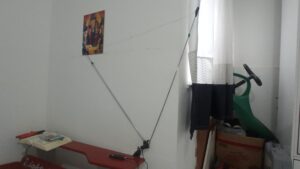
Na imagem, vemos a vinda de nuvens que aparentam ter uma grande densidade em direção à América do Sul, maior parte indo ao sul e sudeste do Brasil.
5 degrees Celcius
88% humidity
974 mb
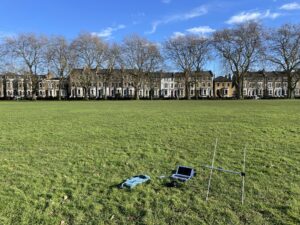
The aftermath of Storm Éowyn is a beautifully calm, sunny and clear day in London.
This is my first time using a home made V dipole antenna.
The storm hasn't left much of a trace- there were barely any high winds in the Southeast, whereas the Met Office issued a very rare 'red' weather warning for Scotland and Northern Ireland, where winds surpassed 100mph, millions were left without power and roads were damaged.
Although the quality doesn't seem to be that good.
Between 2011 and 2024, there were 'red warnings' on just 19 days.
This may be because of the weather or because I somehow didn't build the antenna correctly.
During the same time, 521 days saw amber warnings while 1,922 had yellow warnings.
Keep in mind that I still use a Baofeng Uv5r and a phone to record.
One of the recent red warnings was in July 2022 during the 'severe heatwave' that raised temperatures over 40 degrees Celsius, melted train tracks and started wildfires across the UK.
The weather wasn't great, with a little shower pouring down on my location, lot of fog and the average temp.
I collect a satellite image from the middle of Hackney Downs.
was 4 degrees Celsius.
The orbit is very far to the West of London, only 34 degrees in maximum altitude.
Quite impressed by the range of the transmission being able to see a little of the NNE part of Africa and up to the Baltic Sea.
As the image loads, the prominent swirling cyclone over the Atlantic feels incongruous to the blue sky above.
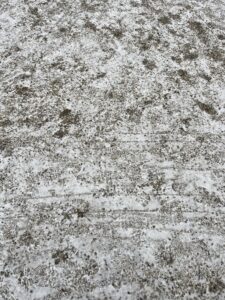
I began to think in "un-"s after reading Naomi Klein's proposal for "unselfing" in resistance to a politics of self-preservation and algorithm-fuelled ego.
It is an image of extreme drama and turbulence.

Around the same time, I realised that adding "un-" to German words is a shortcut to expanding my limited vocabulary.
Here, we are in an envelope of calm.
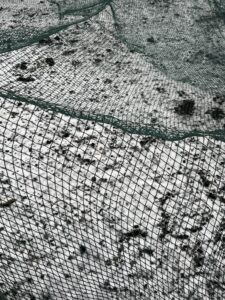
This is how I came across the German word for severe weather, "Unwetter".
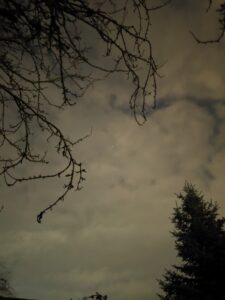
Storm Éowyn is on it's way but they are unclear how it will unfurl.

"Unwetter" is the opposite of "Wetter" and literally translates as un-weather.
I can see from the pass that something is heading towards us off the Atlantic.
This week, the transatlantic weather of Trump's inauguration and the explosive fire weather of Los Angeles has been so severe, it has felt like both an Unwetter and an un-doing.
Warnings are changing from yellow to red and I feel for those who will again experience flooding or winds that will cut power for hours or days.
That is to say, I can see in the people around me how the events of this week have undone certain beliefs about the past or expectations of the future.
We are not a robust country.
At the same time, five days into the ceasefire in Gaza, Palestinians are reckoning with a new un-peace or Unfrieden.
Our red warning is very different from other places on the planet.
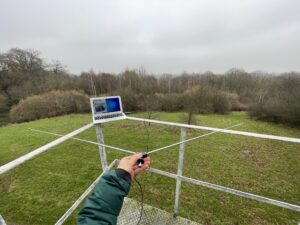
A last minute tutee cancellation gave me a fifteen minute gap in my back to back student meetings, and I snuck out the back of the department to the fire escape overlooking Egham.
The merging of seasons has left us confused and stuck.
It was bitingly cold, but fresh.
Sort paralysed by the bigger picture.
Though the pass was relatively high, the signal struggled to emerge from the static, and I decided the fire escape might not be the best location given interference from heavy machinery, air venting and lab equipment directly adjacent.
A low cloud sits above my head as it glows an unsightly orange from the light of the city.
The news has been filled with the Trump inauguration.
Jupiter's pinpoint of light shines through the blanket of cloud.
For those of us, like my family, who have been directly affected by the LA fires, the slew of executive orders since Monday has felt like another set of fires that were foreshadowed by the burning of Los Angeles over the last two weeks.
This is another night without the stars.
I am still checking the Calfire map many times daily, and stunned that 'containment' of the Palisades fire is still only 63%.
5 degrees Celcius
90% humidity
995 mb
A county infrastructure damage map has recently been released.
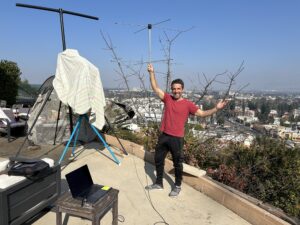
This pass was captured from the Hollywood Hills facing the San Fernando Valley.
It looks like a pointilist painting of red, black, green and yellow, but the coloured dots are houses, schools, cafes, libraries, offices and other structures in various states of damage.
My friend Henry helped out.
The map is mostly red, which means 100% structural damage.
There were some large power cables just overhead which I suspect created a little interference initially.
I found a photo of the house I lived in during high school and couldn't stop looking at it.
The skies were a bit hazy, which is a big change from just the day before.
It is marked as 100% damaged, but unlike other homes that are just piles of rubble, our former house is a hollow cinderblock rectangle with the remainder of the two-story facade pointing to the sky.
I do not think this is related to the fires as they are mostly contained at this point and not actively burning.
The single window in the facade looks like a wide eye.
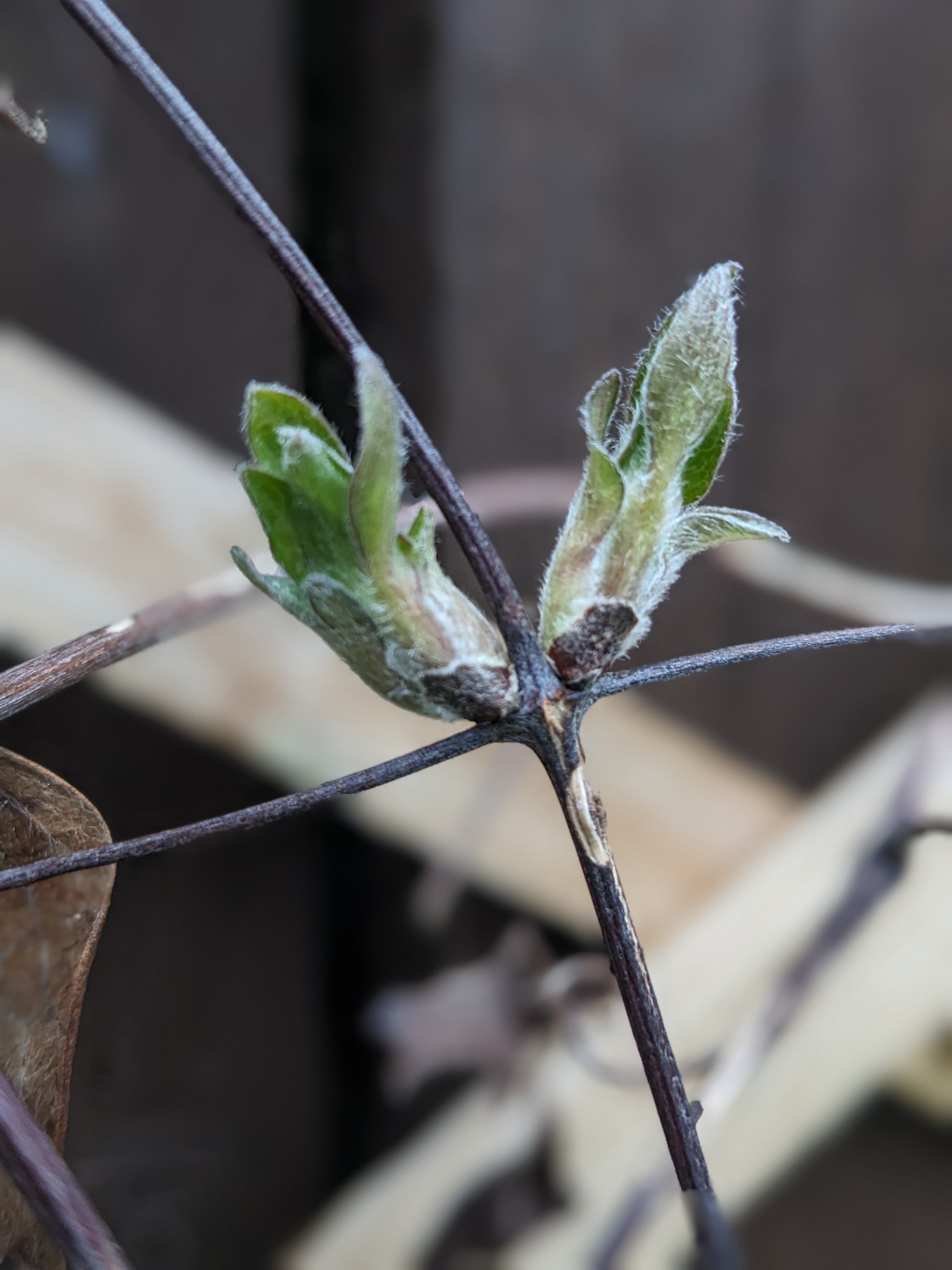
It's mid January and grey.
Everything inside has burned, but because of the existence of the facade and cinderblock walls, it feels like a hollowing-out rather than a burn-to-the-ground.
There is no bird song today.
One can see directly into the corner of the garage where we used to have our family desktop computer- this was where I downloaded music on Limewire for the first time and made CDs for myself and family road trips.
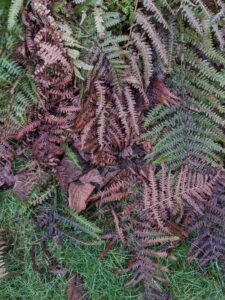
Just one lonely gull flying above land locked and trapped between the desolate winter ground and the concreate pallor of the thick cloud.
It is also the corner of the garage where I sat and chose my first semester's courses at Stanford University.
During the pass I look for signs of spring from plants and fruits that shrivel to nothing to protect themselves.
The remainder of the house is a poetics of space- of corners, bubbles, staircases and windows where so much of my life unfolded.
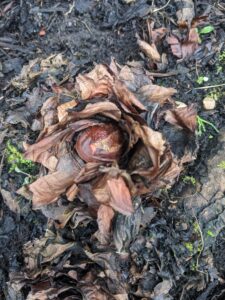
Today's pass isn't clear.
The second story - where my bedroom was - is completely gone, and the ring of tall bamboo that used to surround the house is absent.
An over sight from me for not unravelling the cables properly.
This means the hollow house is open to the sky- in the photograph, this is a pale gray sky that suggests ash still swirling in the air.
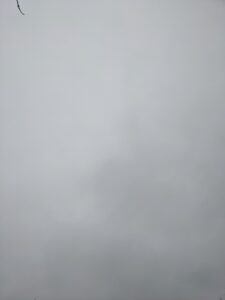
Cracked lines and a broken image seem to echo a deeper global anxiety.
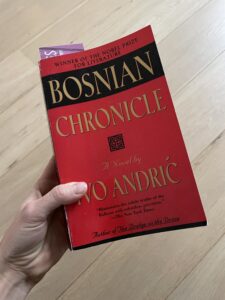
A passage of the novel Bosnian Chronicle (Travnička hronika) by Ivo Andrić accurately depicts London's weather today.
Or maybe it's just January blues.
Reading before bed last night, I marked the page of weather scenography with a large stone, and found it on my desk in the morning - a note to self from the Bosnian town of Travnik in the late 19th century:
"It meant rain and mud and snow; snow that turned to rain while still in the air, rain that became mud as soon as it hit the ground.
2 degrees Celsius
81% humidity
1019 mb
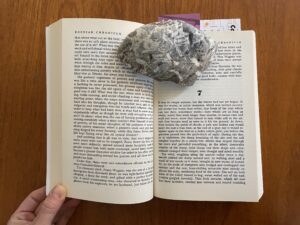
At dawn, from behind the patch of clouds, a pale and listless sun would paint the east a wan rose; at the end of a gray day it would reappear again in teh west as a sickly yellow glow, just before the grayness passed into the pitch-black of night.
Yes, I know the photos look bad, but my rig was a Baofeng UV-5r with the stock whip antenna, recorded with a phone.
During the day, as at nighttime, the damp breathing of the sky and the soil mingled together in a smoke-thin drizzle that seeped through the town and pervaded everything; in the silent, inexorable alembic of the damp, solid things lost their shape and color, animals changed their temper, men thought and acted moodily"
"The wind, soughing along the narrow valley twice a day, merely shifted the damp around and, by wafting sleet and a smell of wet woods as it went, brought new waves of humidity; so the pools of dampness only nudged and overlapped one another and the raw, bone-chilling mountain mist merely replaced the stale, moldering kind in the town"
- Ivo Andrić, Bosnian Chronicle, pp.
The NOAA-15 came today at 6:19 UTC almost over head with 89 degrees of elevation.
109
There was a lot of fog out, humidity 84%.
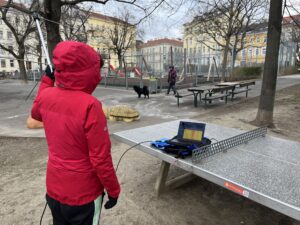
I stood in a flurry of snowflakes that would not settle.
Temp was -3 Celsius.
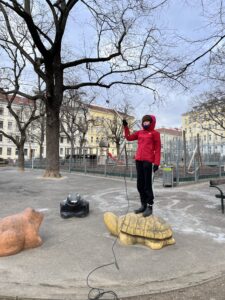
Large, restless and white-grey, they took on the appearance of ashes.
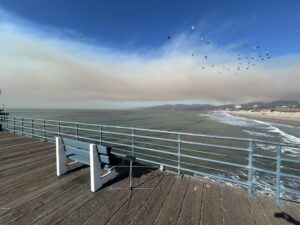
This is day 4 since the Palisades Fire began and it has been quite the rollercoaster.
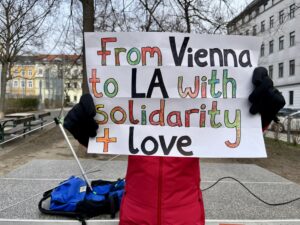
From Vienna to LA, with solidarity and love.
Regardless, NOAA 18 decided to fly over with an elevation of 89°.
This is my first satellite image capture of the year.
You don't get much better than that.
Another cold frosty night.
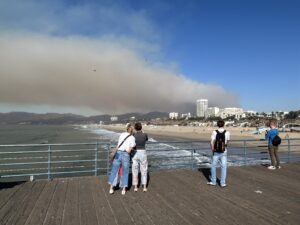
I decided to visit the Santa Monica Pier as it has great exposure to the sky, and is about as close as I can get to the fire zone.
An 80% Moon illuminates the frost on the grass.
One of the top destinations for tourists, there was much activity.
Tiny ice crystals shimmer and glimmer in brightness of the reflected moon light.
A bodyboarder screams as he catches a wave.
I try and spot the satellite overhead but lots of fainter objects are fighting for recognition in the blinding lunar light.
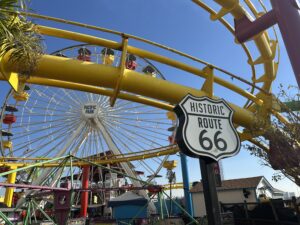
The rollercoaster operator ask his riders if they want to go for a second spin.
There the pin sharp brilliance of Venus to the west, Jupiter to the south east and Mars rising in the east.
A neon sign above a cafe reads, "Salty air, and not a care".
On packing away I walk across the grass leaving footprints that remind me of the moon landings or the fossilised prints left millions of years ago by the dinosaurs.
On a small island of homes, my house defied all odds - standing strong.
As I type this I can hear the news from the next room reporting on the fires in California.
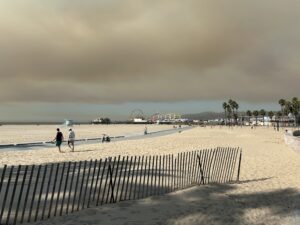
My classroom of 25 years went up in smoke.
What kind of footprints are being left there today and what about the footprints of the generations to come?
About 6 1/2 minutes into the satellite pass you can see a thin strip of clouds headed out to the ocean.
0.1 degrees Celsius
90% humidity
1005 mb
The winds have died down, but the fire continues.
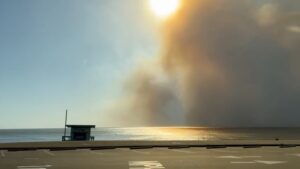
For the Los Angeles fires:
Blame it on the wind: blame it on the ‘devil’s wind’ that gusts over Los Angeles at 60+ mph, ‘fanning the flame’ of five ongoing, devastating wildfires, as yet ‘uncontained’.
At just 11% containment, it is now threatening Brentwood and Encino.
Blame it on the wind, an unpredictable, invisible, seemingly chaotic, uncontrollable force: the easiest scapegoat.
8 months of no rain and some strong winds.
Whose wind is this?
It doesn't take much to change your course.
Who remembers its names or its cultures?
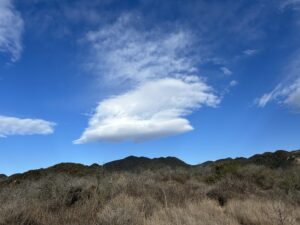
Today is a blustery day in Los Angeles.
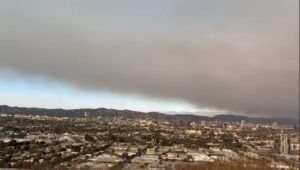
Who is willing to counter the ‘blame’ with the knowledge that a wind like the ‘Santa Ana’ has a cultural history more than 5,000 years old in the lifeways of the Tongva, Tataviam, Serrano, Kizh, and Chumash Peoples, on whose land Los Angeles was settled and built?
The National Weather Service predicts a "life-threatening and destructive" windstorm, with gusts of wind up to 160 kph.
The Santa Ana winds may be arid and dry, originating from the desert of the Great Basin.
Over the last 8 months, southern California hasn't received a rainfall event with more than a few millimeters of precipitation.
These winds may increase static electricity, topple trees, and produce ‘strange luminosities’ in the sky.
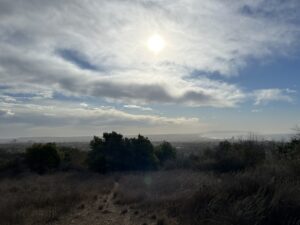
The landscape is dry and the humidity is expected to drop (currently 20%).
Yet being affected by a dry, desert wind is not the same thing as codifying it with sensationalist and ‘demonic’ fears.
A spark from a power line can ignite the extremely flammable brush and then carry embers great distances.
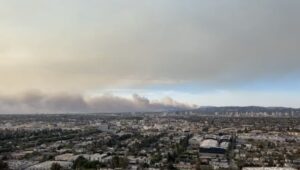
In demonising the wind, whose demonic actions go unnoticed?
"Fire season" used to refer to late August, September and October.
Which demons are free to roam?
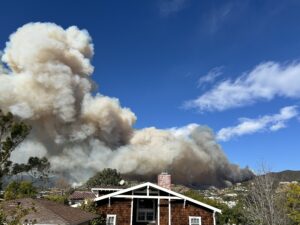
In recent years, some of the worst fires in California history happened in November, December and January.
As we blame the wind, how can we have a conversation about the extractive legacies of water stealing, draining and rerouting?
With a changing climate there is a need to update our terminology.
Or fire suppression tactics that make the world more flammable?
While some people might think this is an excuse to hunker down and ride out the storm, I thought this is a reason to break out the antenna.
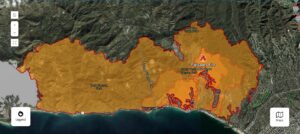
Or centuries of encroachment on more and more arid land?
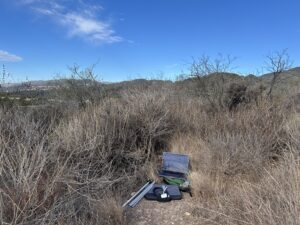
I went up into the hills of the Santa Monica Mountains and captured a pass.
How do we talk about the fact that the logic that pumps money into LAPD and enlists hundreds of incarcerated peoples to fight an uncontainable fire for $4 per day is the very same logic that sends arms to Israel as it burns entire cities and perpetuates another prison?
While writing this weather note, I started hearing sirens.
How do we resist sensationalist narratives of neighbourhoods where “millionaires are getting a taste of the apocalyptic movies they have produced and acted in” to be able to see the marginalised, differently abled, and elderly existing side by side, whose narratives of ‘escape’, or simply survival, are far less appealing to a media elite?
A neighbor sent me a text.
I pray for the sake of my family home (if it still exists) that the wind relents.
I hopped on my roof and watched flames come over a ridge (see image 3).
But this disaster is not about the wind.
Ended up evacuating due to air quality.
(images are screenshots from videos by Steve Engelmann, maps by CalFire, words by me)
It's cold.
A clear cold night.
It's been cold all day.
The winter constellations hang overhead in all their beautiful glory.
I am stood watching Mars and Jupiter fade in out of the clouds along with a quarter Moon.
Orion, Pleiades, Auriga and Taurus drawing out the maps of ancient skies.
There are layers of cloud tonight.
The lawn is crispy underfoot.
Lower ones are moving fast and in small wispy shapes.
The UK is clear on the map except for some small parallel clouds across the counties of Cheshire and the cities of Liverpool and Chester.
The higher clouds glow an orange colour from the light pollution and as I pad around on the lawn during the pass I hear the splashing of water against my boots and I notice that the lawn is water logged in places.
1 degree Celsius
90% humidity
1001 mb
There was so much rain last night and another down pouring of sleet and snow today.
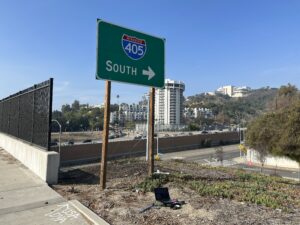
Today I thought I would visit LA's Getty Center.
Airports were shut, roads and rail lines flooded.
They are coordinating a project called PST:ART which includes over 70 exhibitions throughout southern California with a focus on how art and science collide.
More to come.
The Getty Center also has an amazing outdoor area with spectacular views of Los Angeles.
3.1 degrees Celsius
99% humidity
990mb
What a great place to also grab a satellite pass - I thought.
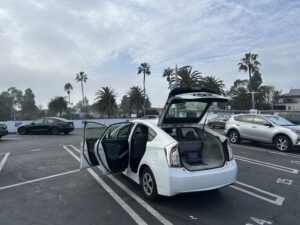
It is hard to pass up an opportunity when a satellite is passing by with an elevation of 87°.
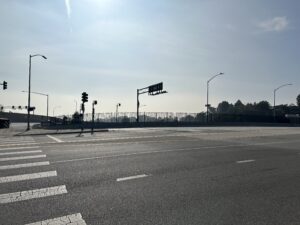
When security took a look at the disassembled antenna I was bringing along, they had second thoughts.
Back in Los Angeles I thought I would try out roof-top parking for an unobstructed view.
I wasn't able to convince security, or her supervisor, that my intentions were harmless.
The skies were mostly cloudy with a cool marine layer bringing in a little fog.
But I've learned to be flexible.

There was also a light scattering of stratocumulus and high cirrus clouds, but no precipitation.
On the spot I hatched a plan B.
The Air Quality Management District initiated an Air Quality Alert.
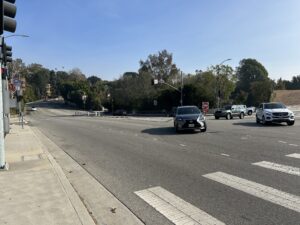
With 20 minutes to go, I used my speed-walking skills to relocate on an overpass where Sunset Blvd crosses the 405 freeway.
An inversion layer, which is common in LA, traps air pollutants low to the ground.
On the first image you can see the Getty Center in the background perched on a hillside.
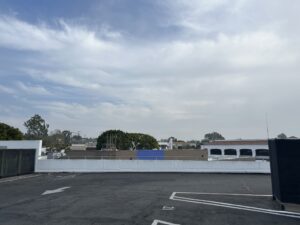
For this reason there is a ban on wood burning.
The view was a step down from the Getty, but also, not bad.
The fine particulates get deep into lungs and can trigger a range of health issues.
I'm sure there were many suspicious looks from the busy street with a strange man pointing an antenna at the sky.
Could use some rain, but nothing in the forecast for the next 10 days.
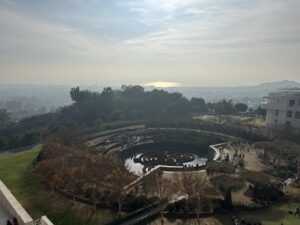
Then again, this is a stone's throw away from Hollywood.
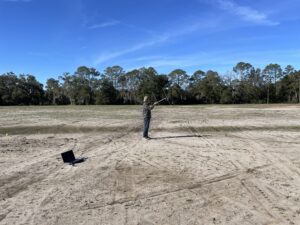
Went out to capture a satellite pass with a super high elevation (87°).
At a little over 8 minutes in, a commuter bus blocked by reception for two seconds.
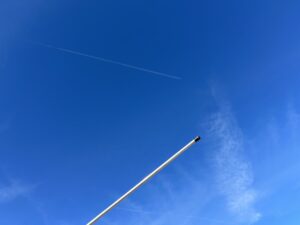
Found an abandoned golf course in the process of being repurposed with a relatively clear skyline.
A line of static documents the interference.
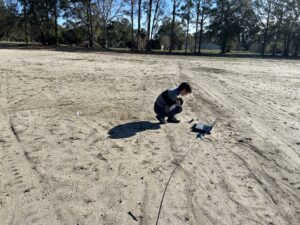
The skies were mostly clear with some cirrus clouds toning down the sunlight.
Life throws us many curveballs.
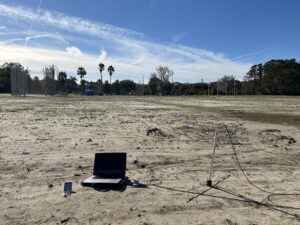
It was a crisp 10°C at 10AM, which seems a bit unexpected for someone not from Florida.
The next four years should be no different.
Just at the satellite was at it's highest point, an airplane left a contrail, as if to mark the spot.
A bright and crisp morning.
A low winter sun brushed over the bare trees and though it tried to break through it was beaten by the cloud.
Blue skies and frost underfoot.
While the pass happened I moved the outside furniture and bins around in preparation for the windy weather that was forecast for the afternoon.
There is a stillness to the day and though it's already the 2nd January the new year feels like it's still slowly unfurling.
10 degrees Celsius
Blue Tits and Robins interject with pips and chirps that are bumped off the musical score by the prehistoric caws and croaks of the corvids.
A night time pass.
The British Isles are clear.
It's 8 degrees Celsius.
A rare sight indeed.
Cloud whispers across the sky.
2 degrees celsius
82% humidity
air pressure 1011 hPa/mb
Jupiter is a small smoky dot that battles for attention.
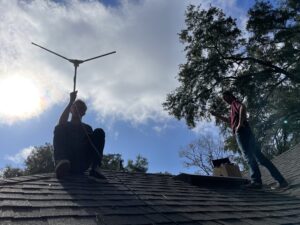
Got up on a roof in central Florida with my nephew to do a little training and compare two different antennas on a satellite pass.
There is a slight breeze and it feels much colder than the temperature states.
The sun came in and out of the clouds often.
90% humidity
1018 air pressure
Combining the warm December temperatures, humidity and the dark roof surface I came down a little sweaty.
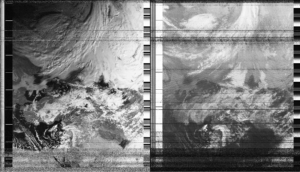
NOAA 19 from Greece at 09:15AM local time ( 07:15 utc time)
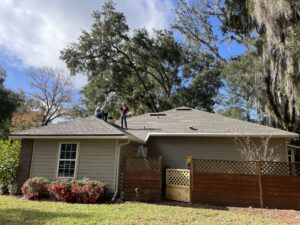
On the last day of 2024 it is always interesting to assess the year that just passed and contemplate what lies ahead.
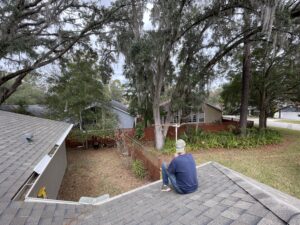
To continue our antenna comparison, we sat on the roof shortly before noon with a weatherised V-Dipole and the tripod- mounted Turnstile, looking north.
2023 was the warmest year on record regarding global temperatures.
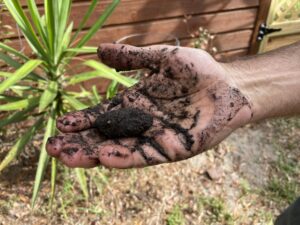
The V-dipole was hooked up to AGS 15, while the Turnstile received via an android phone running SDR++.
The consensus is that 2024 will end up being warmer still.
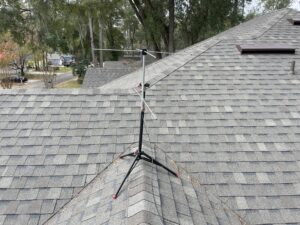
The image attached to this post is from the latter.
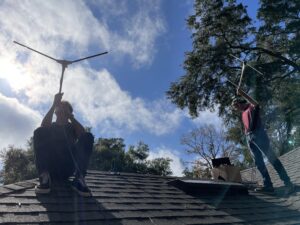
At this moment there is a polar vortex sending frigid temperatures to the midwest and northeast.
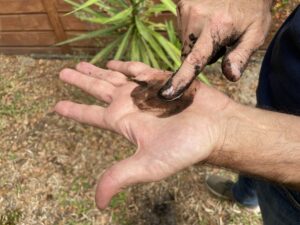
After the pass, Steve did a soil texturing test which revealed the local soil to be ‘loamy sand’.
Ironically, climate change makes these events more likely.
This was my first time picking up a satellite signal!
Searching for opportunities to dial down carbon emissions would be a great new year's resolution.
Very intriguing process.
Tiny amounts of rain at receiving spot.
It was chilly (compared to typical Florida weather) and very cloudy, but not windy.
Image shows some rain clouds over France and Bay of Biscay and just off the coast of Ireland in the Atlantic Ocean.
There's a bit of South America in the lower part of the image, such as the Panama Canal, as well as most of the East Coast.
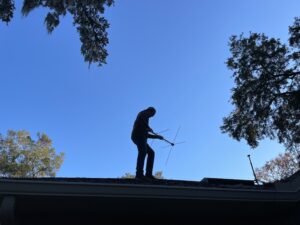
A clear, cool, breezy day here in Florida.
We can see some tougher, perhaps stormy clouds moving in from the bottom.
We stand on separate hills in the former golf course, one of us with a turnstile antenna, another with a v-dipole.
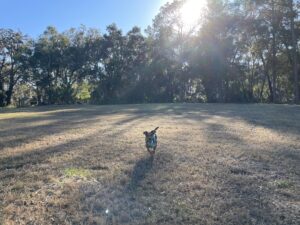
After a few warm, humid days, the air today felt lighter, cooler and clearer.
Later, comparing images, we notice how there is a clear line at the midpoint of the turnstile's image that doesn't appear in the image made with the dipole.
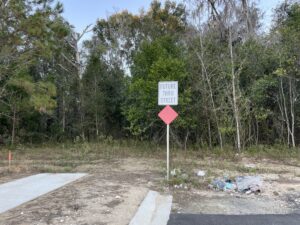
I took a long walk around the neighbourhood, and it wasn't long before I came across the edge.
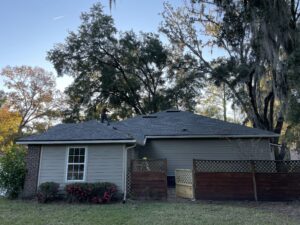
This line is appearing at almost the same spot in previous images collected with the same laptop and antenna - a signature of the laptop?
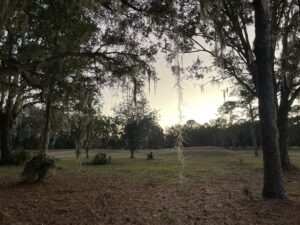
A grid had been carved into the land near a local forest, sandy flats exposed, and the sounds of hammers and staple-guns echoed back and forth.
or a glitch in antenna reception, at the peak of the satellite pass?
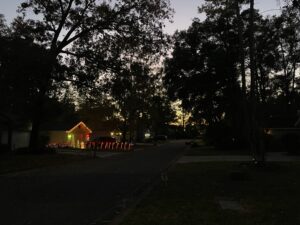
I walked to the very limit of the housing development and found a gap in the trees, but as soon as I entered the forest I could see someone was living there, or at least squatting for a while, in a shelter made of tree branches.
Later in the day, we test the same antenna from the roof, shaded by southern live oaks.
Being alone around sunset, I turned away and found the empty pavement again.
As there is no wind or rain predicted, we tape it to an old camera tripod found in the garage, simply stand it up on the roof's apex, and run a cable through a crack in a window.
As I returned home, the orange sunset light was glowing through the palms, matching in intensity the light-up candy canes on a nearby lawn.
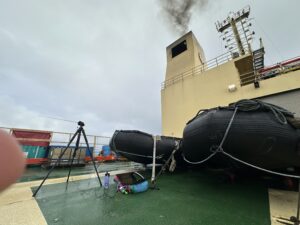
Another day, another storm in the Southern Ocean.
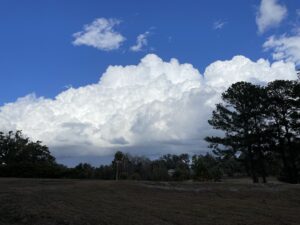
Cumulus clouds tower to the east of "Patio Homes" in Newberry, so sharp and iridescent, they look like they have crystalline facets.
I thought about removing the tip of my finger from my photo of my station, tucked in with the Zodiac boats and surrounded by coring equipment, but it shows a signal of how difficult it can be to operate anything that isn't tied down.
It is muggy today, but I stubbornly wear my Mom's flannel-lined denim jacket on my walk to the local golf-course-turned-park - I am needing protection.
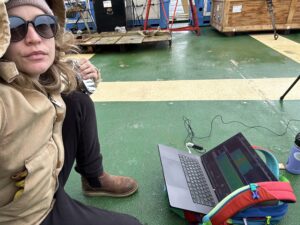
The rolling of the ship and the strength of the mind make any one-handed task just on the edge of impossible.
The political 'climate' of Florida has been on my mind today.
I don't expect to experience weather like this again in my lifetime, but I also don't hold a lot of expectations that anything will remain as expected.
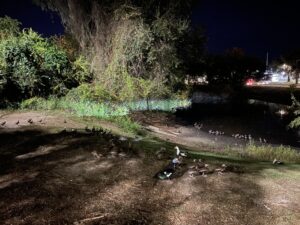
An organisation called Safehome ranks Florida the second most unsafe state in the USA for LGBTQIA+ people based on current legislation and records of hate crimes.
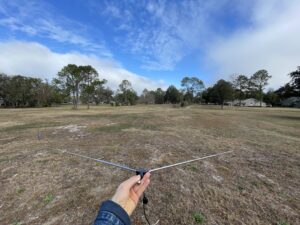
The unusual humidity and warmth woke me up from a dream in a shadowy landscape, and it took me more than a few seconds to realise I was in Florida.
Governor Ron De Santis' GOP-led 'Don't Say Gay' law, passed in 2022, barred instruction on sexual orientation and gender identity in kindergarten through the third grade on its inception, and was later expanded to all grades.
Peaking out the window I saw a suburban street framed by massive palm trees, southern live oak, bald cyprus and lots of ferns.
It had a chilling effect across the state, caused queer teachers to hide photos of partners and take down rainbow flags, queer festivals to be cancelled, and books featuring queer characters to be removed from curriculums.
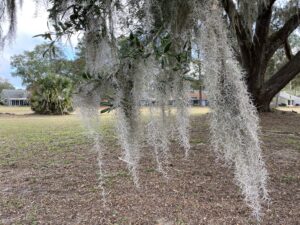
Spanish moss trailed down from the southern live oaks, sometimes so thick it seemed to cover the entire tree.
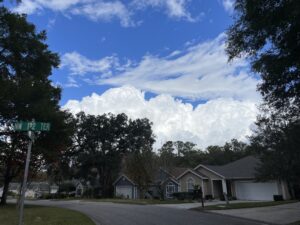
It also inspired a series of other similar laws in states like Arkansas, Alabama, Indiana and North Carolina.
On a morning walk I discovered what seems to be an old golf course turned into a neighbourhood park, and I climbed the only hill (a very small mound) to see further across.
A 2024 'settlement' clarified that LGBTQIA+ discussion can happen in classrooms "as long as it is not part of official instruction", and that the law doesn't apply to books with incidental references to LGBTQ+ characters or same-sex couples, "as they are not instruction on sexual orientation or gender identity any more than a math problem asking students to add bushels of apples is instruction on apple farming".
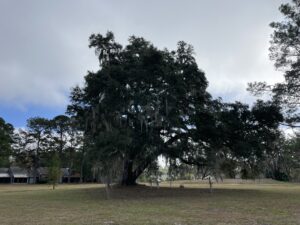
As the landscape is so flat, I could see further than expected.
Though it is a relief to know that some books are being allowed back 'in', it is frightening to think they were removed from teaching in the first place, and the comparison between queer characters and 'bushels of apples' feels particularly wrong.
On the other side of the cul-de-sac where I slept, there appeared to be a quarry full of excavation machinery and a bright turquoise pond, a bit too turquoise to be non-toxic.
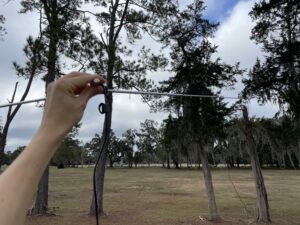
Ron De Santis called the 'settlement' a 'huge win'.
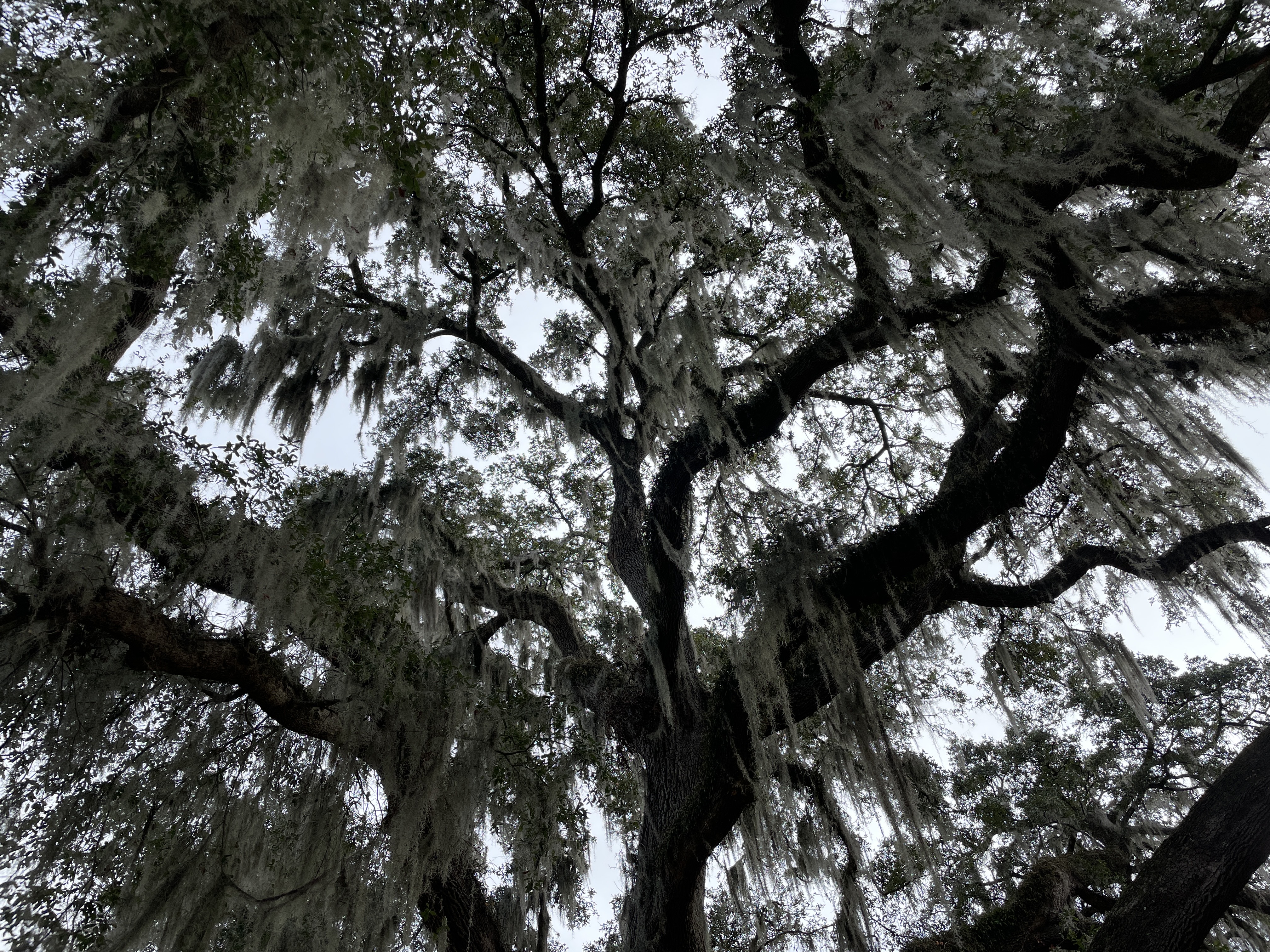
As I listened to NOAA-19, a group of men in high viz outfits drove up and down the golf course in small open door vehicles that appeared to be cutting the dry, light brown grass.
In August 2024, all of the webpages on the Florida state tourism website related to LGBTQIA+ resources and travel advice were quietly removed.
I watched them run over and over the same spots, and wondered what the purpose of this was- a seemingly futile looking attempt at edge-maintenance, kicking up small clouds of dust.
On my walk back to 7th street, I notice two American flags raised high on a dedicated pole in the front yard of an olive green house.
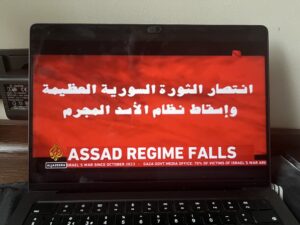
I lean out of the hotel window to catch a noisy signal.
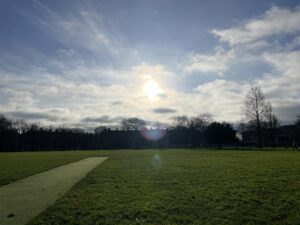
Today is my last satellite pass in London during the year-long attempt at capturing satellite images and weather observations that began on the solstice in December 2023 and will come to an end in a few days.
The signal and noise come in waves: signal rising, noise rising, signal rising, rising, rising, rising.
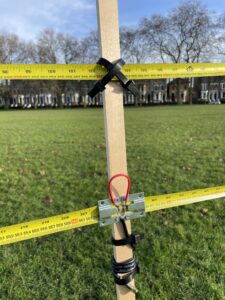
Hackney Downs was the best version of itself for the occasion, a low-lying sun shining across the grass, and reflections from apartment block windows adding a kind of sparkle or glimmer.
"Assad’s gone." "I told you," my closest Syrian friend writes from Hong Kong.
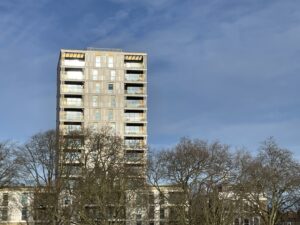
Tomorrow I travel to Florida to visit my Mom who moved there a few months ago.
"How are you celebrating?" I ask.
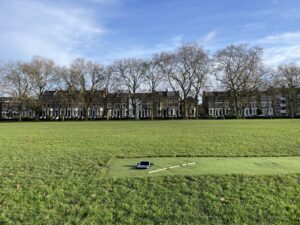
As I traced the typical arc of the satellite orbit, I realised I would need to invent a somatic ritual for this year's solstice- both as a way to recognise the culmination of this near-daily practice of satellite image capture and weather sensing, but also as a means to start a new cycle, a new set of practices that I can't quite foresee yet.
He sends a photo of him looking sharp, wearing a Mercedes cap, with a keffiyeh draped over his shoulders, holding a slice of red velvet cake.
On a call with two very good friends later in the afternoon, this sentiment was confirmed.
"U have no idea how ecstatic I am," he writes.
Speaking a set of rituals they have carried out during a time of transition, a time that is joyous but not without difficulty, one of them said "everything is meaningful, everything is magical - it has to be".
No one I know believed that this day would come.
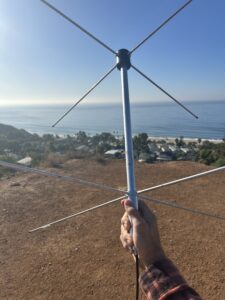
The view from the bluffs was a sunny and calm Pacific Ocean with only a distant layer of low clouds hugging the horizon.
And, at what cost?
A fifteen minute drive north along the coast would take you to Malibu where roads are closed due to the Franklin fire.
"I'd written off a future without Assad," WhatApps a former human rights colleague who, in 2016 interviewed survivors of Saydnaya Prison.

A week earlier a fire erupted late at night.
I recall her saying that the investigation had almost folded as they could not find enough interviewees because so few people left the prison alive.
8 homes were burned as Santa Ana winds gusted to 100 kph and humidity levels dropped to 5%.
I watch on Al Jazeera as a stream of men and women walk up a dirt path between mine fields, into the open gates of Saydnaya.

Pepperdine University was completely surrounded.
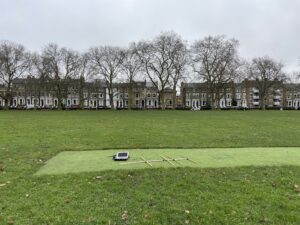
London is all glare and reflection today as a very low cloud-mist settles over the city.
The fire stands at 43% containment, but dry winds are expected to return in a few days.
The sheen of street signs, asphalt, vans, and buses makes everything more obviously aggressive and frantic.
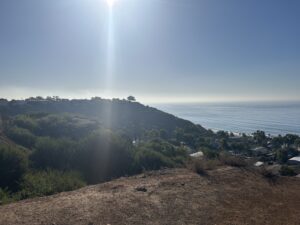
In November of 2018, the Woolsey fire burned 97,000 acres in just a few days.
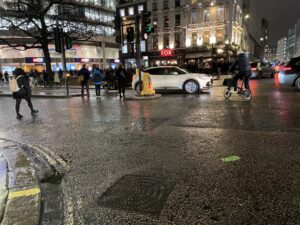
As I cycle to south London after dark, a white Prius pulls out in front of my bike, so close I have to skid to a halt.
The term "fire season" has little meaning at this point.
When the driver looks over his shoulder, and sees me braking and motioning my fright, he hardly blinks as he merges into the centre of the road.
Insurance companies have been refusing to write new policies due to the increased risk of loss due to the changing climate.
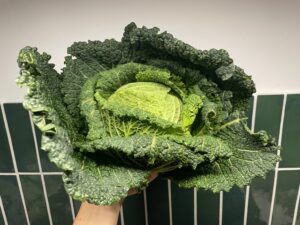
The tops of tall buildings are drowned in cloud so it feels like we are living in a reduced space, the ceiling coming down.
This last week California agreed to allow insurance companies to increase their premiums in response to the new climate reality.
I am reminded of the fictional city Ravicka in Renee Gladman's novel Event Factory.

This is the farthest south towards Antarctica my body would go, although I didn't really put that together at the time I was receiving this image.
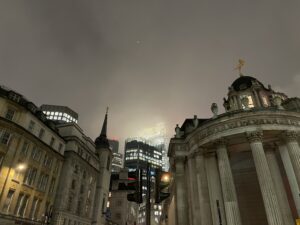
Ravicka is a city of smoggy, ‘yellow air’ that, “vibrates around the foreigner in the street” (Gladman, 2010: 41).
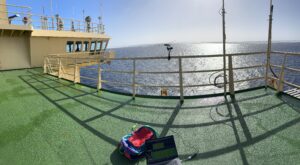
This day was sunny and clear, which was very rare to see during my trip through the Southern Ocean.
Edges and borders shape-shift as the city appears to rearrange itself, or, as the main character observes, “the singing structure eludes me” (Gladman, 2010: 93).
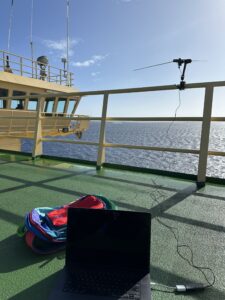
The second mate has told be this is the grayest, stormiest research cruise he's ever been on.
Today, in Gaza, a house was flattened in the packed Nuseirat refugee camp, while two separate strikes targeted local workers securing aid convoys.

But this particular morning broke clear and bright and while it got a bit dark midday the afternoon was sunny again which offered a shadow of the ship onto the pancake ice.
US officials claim they have a 'jurisdictional dispute' with the ICJ and reject its call for arrest of Netanyahu and Yoav Gallant; another 'structure' that continues to elude.
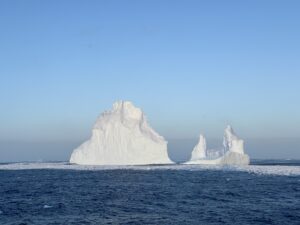
Later, at what would be considered night but is in fact still light, the people of the ship would all pour out onto the decks to see the last glorious iceberg patch we would end up having passed through.
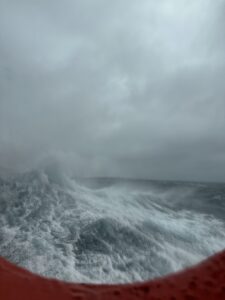
This is an image taken from the porthole next to my desk on the RVIB Nathaniel B.
The remainder of the time at sea would be in open ocean.
Palmer on the day I imaged the weather.

Whether by icy air or circulation of blood, the act of going out for a satellite pass at lunchtime managed to break a mild migraine - my first ever, I think - that had been ongoing for the last twenty four hours despite many painkillers, salves, and hours lying down.
Typically the weather decks on the ship are closed during storms like this, but I was allowed outside to take my satellite reading.
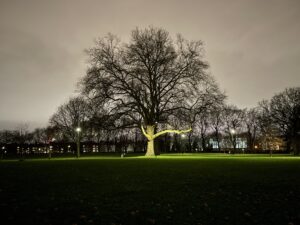
By the time my brain and vision had relaxed from the pain enough for my senses to be alert to detail in the world, the sun had fallen.
It was so windy I had to hold onto the antenna and my computer the entire time.
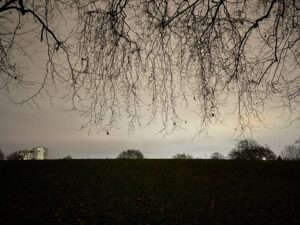
I haunted the park at night, peering into blue-lit windows and noticing the ways streetlights highlighted the elegant curves of plane tree branches from below.
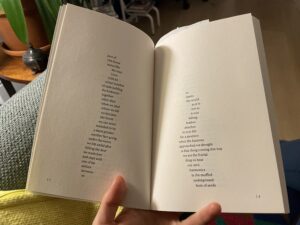
to / desire / the world / as it is / not as / it was / falling / feather / attaches / to new life
The third poem in CA Conrad's book 'Listen to the Golden Boomerang Return' makes me forget to breathe while I read it over coffee.
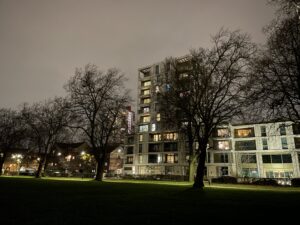
A faint oval-shaped pink cloud hovered over one hill of the park like an omen.
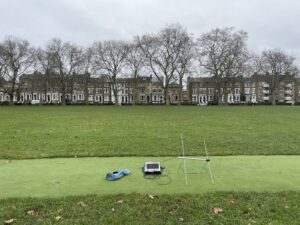
for a moment / when the hammer / approached we thought / is that thing coming this way
I think of the many 'hammers' still falling on Gaza, on Syria and Lebanon, and of the metaphor of a meteor strike as world ending event, when we already have so many-
we are the fractal / drop to hear / our own / harmonics / in the muffled / underground / hum of seeds
Two dogs tossed and tumbled in the dark, their paws vying for dominance and their teeth glowing.
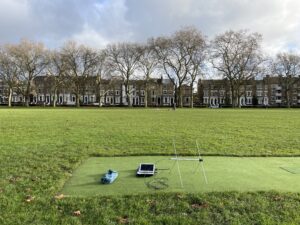
The sky was a thin, eggshell blue when T and I woke up this morning.
They were eerily quiet except for their panting breaths.
Two cats, a ginger and a spotted black one, were playing hide and seek in the overgrown grass of the back garden.
A person pushing a baby stroller walked briskly along a lit path with a tied up Christmas tree slung across their back.
For a few hours, perhaps three or four, the sun shone in London, but the night came so quickly that every flat on the street had lamps turned on by three.